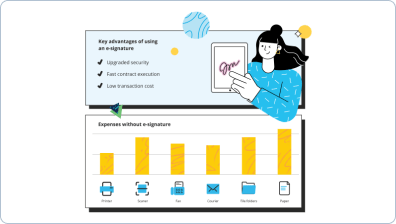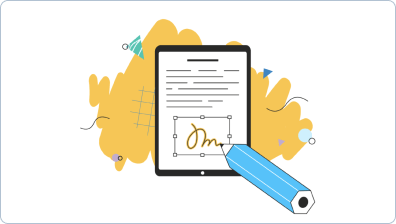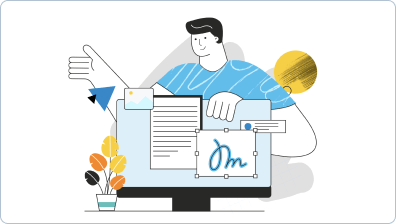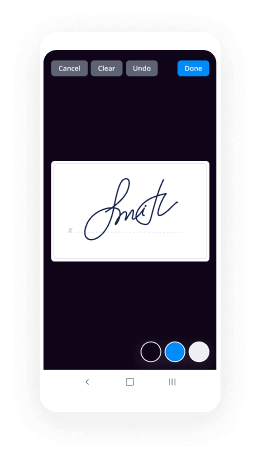eSignature Digital Signature Encryption
- Quick to start
- Easy-to-use
- 24/7 support
Simplified document journeys for small teams and individuals




We spread the word about digital transformation
Why choose airSlate SignNow
-
Free 7-day trial. Choose the plan you need and try it risk-free.
-
Honest pricing for full-featured plans. airSlate SignNow offers subscription plans with no overages or hidden fees at renewal.
-
Enterprise-grade security. airSlate SignNow helps you comply with global security standards.







Get the most from your eSignatures with airSlate SignNow
Accelerate work with documentation
Modify forms safely
Share files
Use Digital signature and encryption
Incorporate eSignatures via API
Make simple workflows
Quick guide on how to use esignature digital signature encryption feature
Is your organization ready to cut inefficiencies by three-quarters or more? With airSlate SignNow eSignature, weeks of contract negotiation become days, and hours of signature collection turn into a few minutes. You won't need to learn everything from scratch thanks to the user-friendly interface and easy-to-follow instructions.
Take the following steps listed below to use the encrypted signature functionality in minutes:
- Open your web browser and go to signnow.com.
- Subscribe for a free trial or log in utilizing your electronic mail or Google/Facebook credentials.
- Click on User Avatar -> My Account at the top-right area of the webpage.
- Customize your User Profile by adding personal information and changing configurations.
- Create and manage your Default Signature(s).
- Return to the dashboard webpage.
- Hover over the Upload and Create button and choose the appropriate option.
- Click on the Prepare and Send option next to the document's title.
- Input the email address and name of all signers in the pop-up window that opens.
- Make use of the Start adding fields option to proceed to modify file and self sign them.
- Click on SAVE AND INVITE when you're done.
- Continue to configure your eSignature workflow employing advanced features.
It can't get any easier to use the digital encryption signature feature. It's available on your mobile devices as well. Install the airSlate SignNow application for iOS or Android and manage your custom eSignature workflows even while on the go. Forget printing and scanning, labor-intensive filing, and costly papers shipping.
How it works
Rate digital encryption signature
What is the encrypted signature
An encrypted signature is a secure method of signing documents electronically, ensuring that the signer's identity is verified and the integrity of the document is maintained. This type of signature uses cryptographic techniques to create a unique digital signature that is tied to the signer's identity. The encrypted signature ensures that any alterations to the document after signing can be detected, providing a high level of security and trust in electronic transactions.
How to use the encrypted signature
Using an encrypted signature involves a few straightforward steps. First, you need to upload the document you wish to sign onto the airSlate SignNow platform. Once uploaded, you can select the option to eSign the document. The platform will guide you through the process of creating your encrypted signature, which includes verifying your identity. After signing, the document is securely stored, and you can share it with other parties as needed.
Steps to complete the encrypted signature
Completing an encrypted signature is a simple process:
- Log in to your airSlate SignNow account.
- Upload the document you need to sign.
- Select the option to eSign the document.
- Follow the prompts to create your encrypted signature, which may include identity verification.
- Review the signed document to ensure accuracy.
- Save or share the signed document as required.
Legal use of the encrypted signature
Encrypted signatures are legally recognized in the United States under the Electronic Signatures in Global and National Commerce (ESIGN) Act and the Uniform Electronic Transactions Act (UETA). These laws affirm that electronic signatures hold the same legal weight as traditional handwritten signatures, provided that both parties consent to use electronic methods for signing. It is important to ensure compliance with any specific state laws that may apply to your documents.
Security & Compliance Guidelines
When using encrypted signatures, it is essential to follow security and compliance guidelines to protect sensitive information. Ensure that the platform you use employs robust encryption methods to safeguard your data. Regularly update your passwords and enable two-factor authentication for added security. Additionally, familiarize yourself with compliance requirements related to electronic signatures in your industry to ensure that your practices align with legal standards.
Examples of using the encrypted signature
Encrypted signatures can be utilized in various scenarios, including:
- Signing contracts and agreements in business transactions.
- Completing tax forms and financial documents securely.
- Obtaining consent for medical forms and patient records.
- Finalizing real estate documents during property transactions.
Documents You Can Sign
With encrypted signatures, you can sign a wide range of documents, including:
- Legal contracts
- Employment agreements
- Non-disclosure agreements (NDAs)
- Tax documents
- Loan agreements
-
Best ROI. Our customers achieve an average 7x ROI within the first six months.
-
Scales with your use cases. From SMBs to mid-market, airSlate SignNow delivers results for businesses of all sizes.
-
Intuitive UI and API. Sign and send documents from your apps in minutes.
FAQs digital signature and encryption
-
What is esignature digital signature encryption?
Esignature digital signature encryption is a technology that secures electronic signatures by encrypting the data associated with the signature. This ensures that the signature is authentic and has not been tampered with, providing a high level of security for your documents.
-
How does airSlate SignNow ensure the security of esignature digital signature encryption?
AirSlate SignNow employs advanced encryption protocols to protect your documents and signatures. Our platform uses industry-standard encryption methods to ensure that all data transmitted during the signing process is secure and confidential.
-
What are the benefits of using esignature digital signature encryption?
Using esignature digital signature encryption enhances the security and integrity of your documents. It provides legal validity to electronic signatures, reduces the risk of fraud, and ensures compliance with regulations, making it a reliable choice for businesses.
-
Is airSlate SignNow cost-effective for businesses looking for esignature digital signature encryption?
Yes, airSlate SignNow offers a cost-effective solution for businesses seeking esignature digital signature encryption. Our pricing plans are designed to accommodate various business sizes and needs, ensuring you get the best value for your investment.
-
Can I integrate airSlate SignNow with other applications for esignature digital signature encryption?
Absolutely! AirSlate SignNow provides seamless integrations with a variety of applications, allowing you to incorporate esignature digital signature encryption into your existing workflows. This enhances productivity and streamlines document management across platforms.
-
What types of documents can I sign using esignature digital signature encryption?
You can sign a wide range of documents using esignature digital signature encryption with airSlate SignNow. This includes contracts, agreements, forms, and any other documents that require a legally binding signature, ensuring your transactions are secure.
-
How does airSlate SignNow handle compliance with esignature digital signature encryption?
AirSlate SignNow is compliant with major e-signature laws, including the ESIGN Act and UETA. Our esignature digital signature encryption meets legal standards, ensuring that your electronic signatures are valid and enforceable in court.
Esignature digital signature encryption
Trusted eSignature solution - digital signature encryption
Related searches to digital signature in cryptography geeksforgeeks
Join over 28 million airSlate SignNow users
Get more for electronic signature encryption
- Unlock eSignature Legitimacy for Entertainment in the ...
- Enhance eSignature legitimacy for Entertainment in ...
- Achieve eSignature Legitimacy for Entertainment in ...
- Enhance the Legitimacy of Your Entertainment Business ...
- Unlock the Power of eSignature Legitimacy for ...
- Unlock the Power of eSignature Legitimacy for Education ...
- Unlocking eSignature Legitimacy for Education in United ...
- Unlock eSignature Legitimacy for Education in Australia ...
The ins and outs of eSignature




















































